Gore Tex Question Answer 2022
VerifiedAdded on 2022/09/25
|8
|1835
|22
AI Summary
Contribute Materials
Your contribution can guide someone’s learning journey. Share your
documents today.
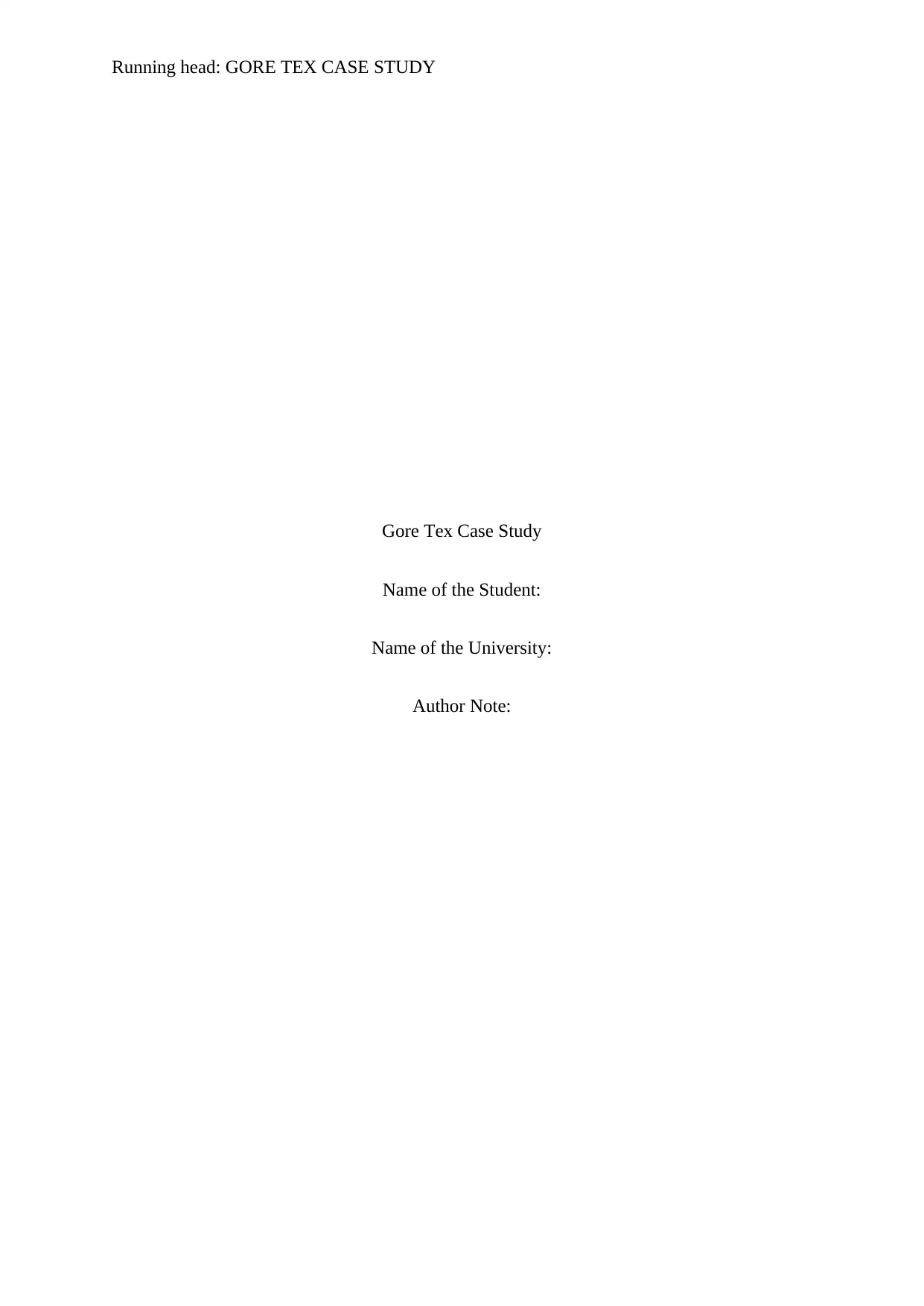
Running head: GORE TEX CASE STUDY
Gore Tex Case Study
Name of the Student:
Name of the University:
Author Note:
Gore Tex Case Study
Name of the Student:
Name of the University:
Author Note:
Secure Best Marks with AI Grader
Need help grading? Try our AI Grader for instant feedback on your assignments.
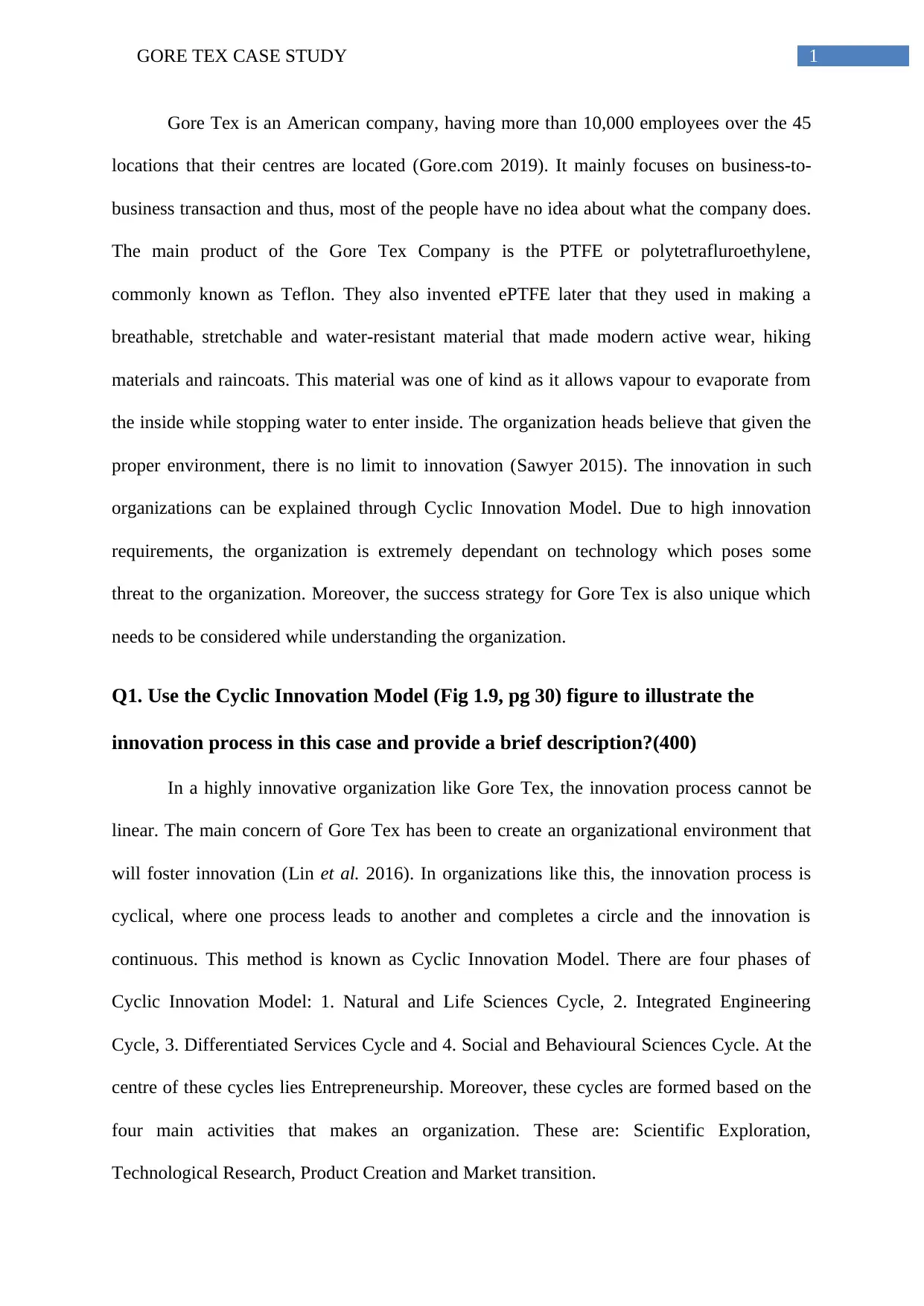
1GORE TEX CASE STUDY
Gore Tex is an American company, having more than 10,000 employees over the 45
locations that their centres are located (Gore.com 2019). It mainly focuses on business-to-
business transaction and thus, most of the people have no idea about what the company does.
The main product of the Gore Tex Company is the PTFE or polytetrafluroethylene,
commonly known as Teflon. They also invented ePTFE later that they used in making a
breathable, stretchable and water-resistant material that made modern active wear, hiking
materials and raincoats. This material was one of kind as it allows vapour to evaporate from
the inside while stopping water to enter inside. The organization heads believe that given the
proper environment, there is no limit to innovation (Sawyer 2015). The innovation in such
organizations can be explained through Cyclic Innovation Model. Due to high innovation
requirements, the organization is extremely dependant on technology which poses some
threat to the organization. Moreover, the success strategy for Gore Tex is also unique which
needs to be considered while understanding the organization.
Q1. Use the Cyclic Innovation Model (Fig 1.9, pg 30) figure to illustrate the
innovation process in this case and provide a brief description?(400)
In a highly innovative organization like Gore Tex, the innovation process cannot be
linear. The main concern of Gore Tex has been to create an organizational environment that
will foster innovation (Lin et al. 2016). In organizations like this, the innovation process is
cyclical, where one process leads to another and completes a circle and the innovation is
continuous. This method is known as Cyclic Innovation Model. There are four phases of
Cyclic Innovation Model: 1. Natural and Life Sciences Cycle, 2. Integrated Engineering
Cycle, 3. Differentiated Services Cycle and 4. Social and Behavioural Sciences Cycle. At the
centre of these cycles lies Entrepreneurship. Moreover, these cycles are formed based on the
four main activities that makes an organization. These are: Scientific Exploration,
Technological Research, Product Creation and Market transition.
Gore Tex is an American company, having more than 10,000 employees over the 45
locations that their centres are located (Gore.com 2019). It mainly focuses on business-to-
business transaction and thus, most of the people have no idea about what the company does.
The main product of the Gore Tex Company is the PTFE or polytetrafluroethylene,
commonly known as Teflon. They also invented ePTFE later that they used in making a
breathable, stretchable and water-resistant material that made modern active wear, hiking
materials and raincoats. This material was one of kind as it allows vapour to evaporate from
the inside while stopping water to enter inside. The organization heads believe that given the
proper environment, there is no limit to innovation (Sawyer 2015). The innovation in such
organizations can be explained through Cyclic Innovation Model. Due to high innovation
requirements, the organization is extremely dependant on technology which poses some
threat to the organization. Moreover, the success strategy for Gore Tex is also unique which
needs to be considered while understanding the organization.
Q1. Use the Cyclic Innovation Model (Fig 1.9, pg 30) figure to illustrate the
innovation process in this case and provide a brief description?(400)
In a highly innovative organization like Gore Tex, the innovation process cannot be
linear. The main concern of Gore Tex has been to create an organizational environment that
will foster innovation (Lin et al. 2016). In organizations like this, the innovation process is
cyclical, where one process leads to another and completes a circle and the innovation is
continuous. This method is known as Cyclic Innovation Model. There are four phases of
Cyclic Innovation Model: 1. Natural and Life Sciences Cycle, 2. Integrated Engineering
Cycle, 3. Differentiated Services Cycle and 4. Social and Behavioural Sciences Cycle. At the
centre of these cycles lies Entrepreneurship. Moreover, these cycles are formed based on the
four main activities that makes an organization. These are: Scientific Exploration,
Technological Research, Product Creation and Market transition.
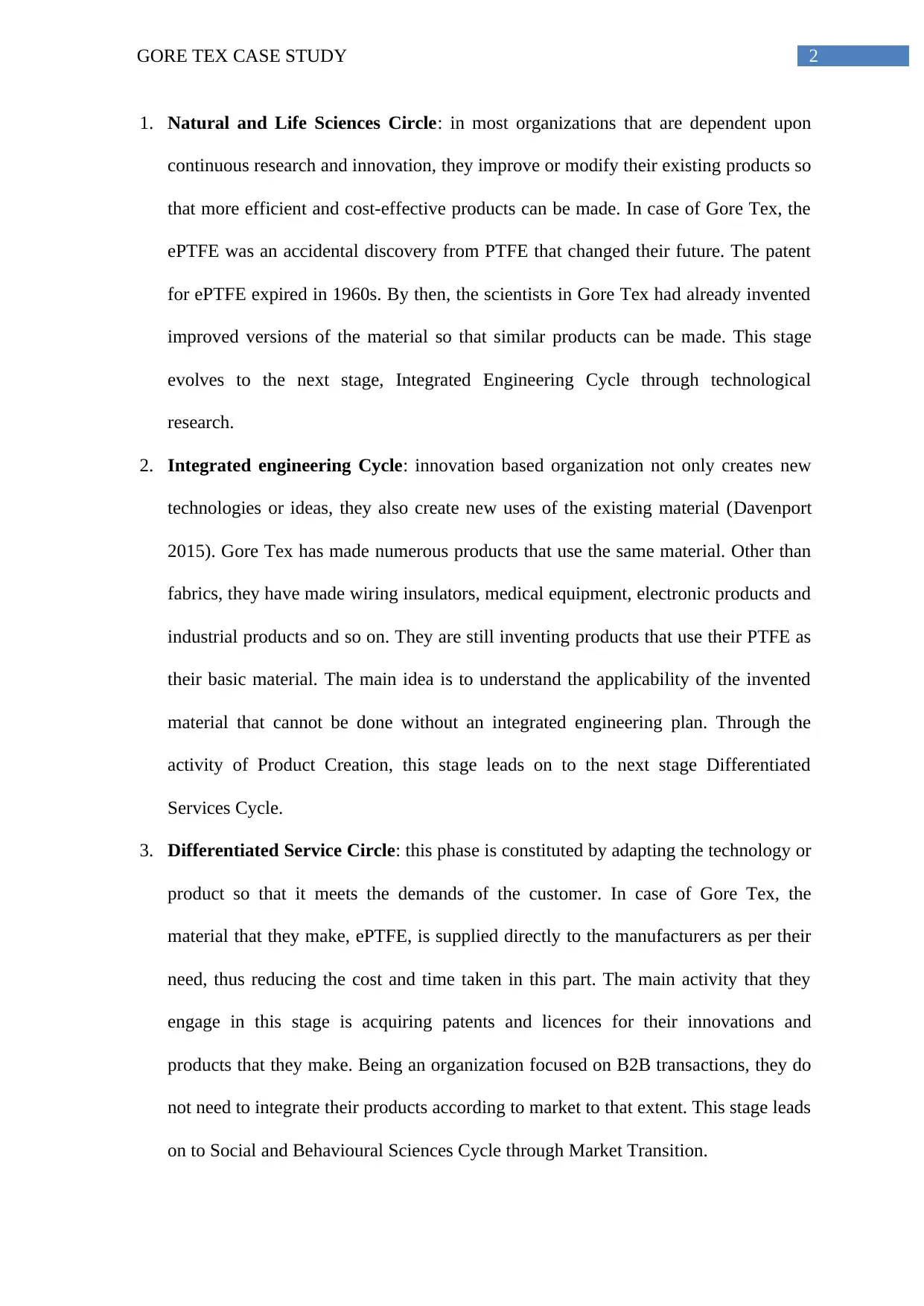
2GORE TEX CASE STUDY
1. Natural and Life Sciences Circle: in most organizations that are dependent upon
continuous research and innovation, they improve or modify their existing products so
that more efficient and cost-effective products can be made. In case of Gore Tex, the
ePTFE was an accidental discovery from PTFE that changed their future. The patent
for ePTFE expired in 1960s. By then, the scientists in Gore Tex had already invented
improved versions of the material so that similar products can be made. This stage
evolves to the next stage, Integrated Engineering Cycle through technological
research.
2. Integrated engineering Cycle: innovation based organization not only creates new
technologies or ideas, they also create new uses of the existing material (Davenport
2015). Gore Tex has made numerous products that use the same material. Other than
fabrics, they have made wiring insulators, medical equipment, electronic products and
industrial products and so on. They are still inventing products that use their PTFE as
their basic material. The main idea is to understand the applicability of the invented
material that cannot be done without an integrated engineering plan. Through the
activity of Product Creation, this stage leads on to the next stage Differentiated
Services Cycle.
3. Differentiated Service Circle: this phase is constituted by adapting the technology or
product so that it meets the demands of the customer. In case of Gore Tex, the
material that they make, ePTFE, is supplied directly to the manufacturers as per their
need, thus reducing the cost and time taken in this part. The main activity that they
engage in this stage is acquiring patents and licences for their innovations and
products that they make. Being an organization focused on B2B transactions, they do
not need to integrate their products according to market to that extent. This stage leads
on to Social and Behavioural Sciences Cycle through Market Transition.
1. Natural and Life Sciences Circle: in most organizations that are dependent upon
continuous research and innovation, they improve or modify their existing products so
that more efficient and cost-effective products can be made. In case of Gore Tex, the
ePTFE was an accidental discovery from PTFE that changed their future. The patent
for ePTFE expired in 1960s. By then, the scientists in Gore Tex had already invented
improved versions of the material so that similar products can be made. This stage
evolves to the next stage, Integrated Engineering Cycle through technological
research.
2. Integrated engineering Cycle: innovation based organization not only creates new
technologies or ideas, they also create new uses of the existing material (Davenport
2015). Gore Tex has made numerous products that use the same material. Other than
fabrics, they have made wiring insulators, medical equipment, electronic products and
industrial products and so on. They are still inventing products that use their PTFE as
their basic material. The main idea is to understand the applicability of the invented
material that cannot be done without an integrated engineering plan. Through the
activity of Product Creation, this stage leads on to the next stage Differentiated
Services Cycle.
3. Differentiated Service Circle: this phase is constituted by adapting the technology or
product so that it meets the demands of the customer. In case of Gore Tex, the
material that they make, ePTFE, is supplied directly to the manufacturers as per their
need, thus reducing the cost and time taken in this part. The main activity that they
engage in this stage is acquiring patents and licences for their innovations and
products that they make. Being an organization focused on B2B transactions, they do
not need to integrate their products according to market to that extent. This stage leads
on to Social and Behavioural Sciences Cycle through Market Transition.
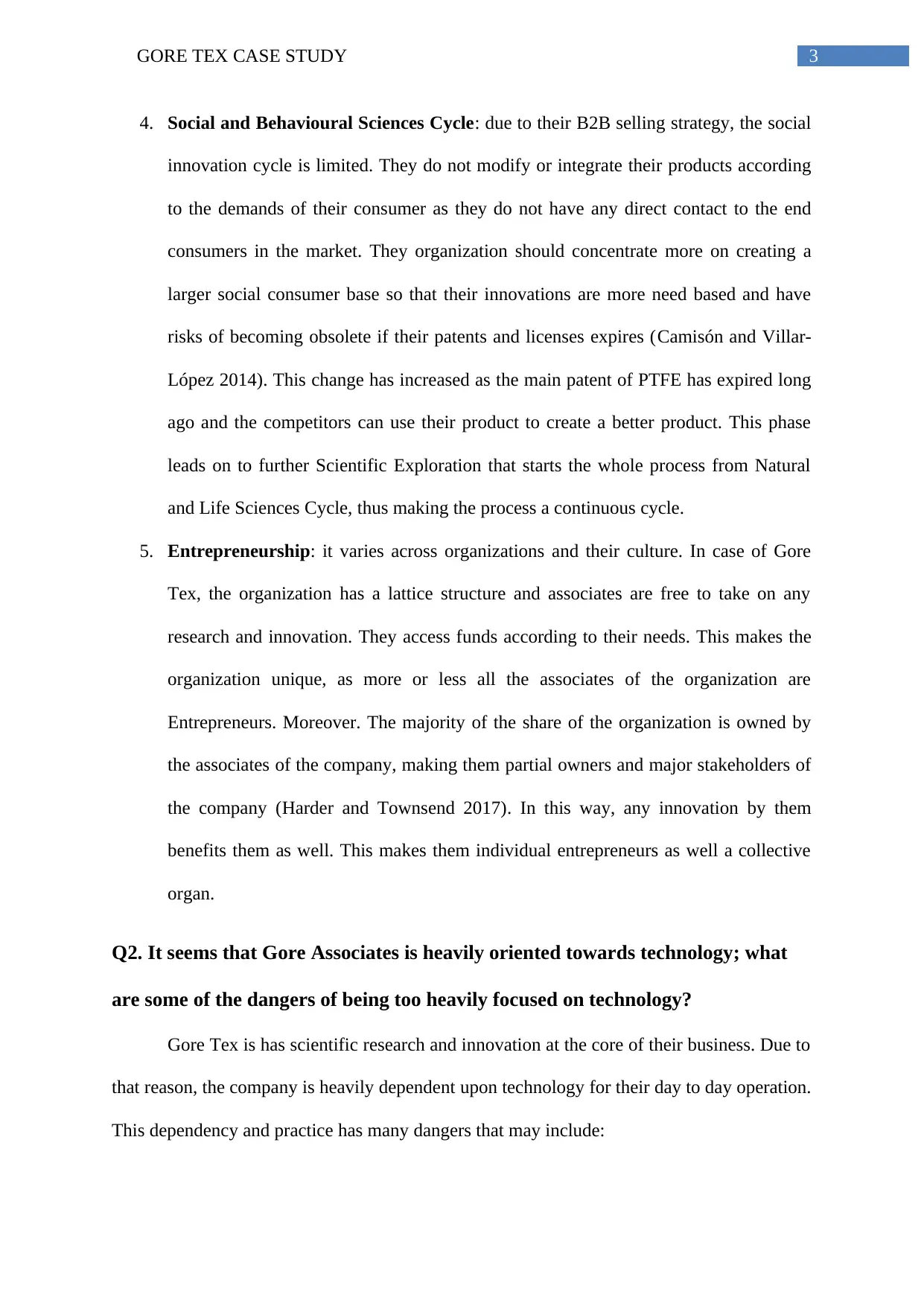
3GORE TEX CASE STUDY
4. Social and Behavioural Sciences Cycle: due to their B2B selling strategy, the social
innovation cycle is limited. They do not modify or integrate their products according
to the demands of their consumer as they do not have any direct contact to the end
consumers in the market. They organization should concentrate more on creating a
larger social consumer base so that their innovations are more need based and have
risks of becoming obsolete if their patents and licenses expires (Camisón and Villar-
López 2014). This change has increased as the main patent of PTFE has expired long
ago and the competitors can use their product to create a better product. This phase
leads on to further Scientific Exploration that starts the whole process from Natural
and Life Sciences Cycle, thus making the process a continuous cycle.
5. Entrepreneurship: it varies across organizations and their culture. In case of Gore
Tex, the organization has a lattice structure and associates are free to take on any
research and innovation. They access funds according to their needs. This makes the
organization unique, as more or less all the associates of the organization are
Entrepreneurs. Moreover. The majority of the share of the organization is owned by
the associates of the company, making them partial owners and major stakeholders of
the company (Harder and Townsend 2017). In this way, any innovation by them
benefits them as well. This makes them individual entrepreneurs as well a collective
organ.
Q2. It seems that Gore Associates is heavily oriented towards technology; what
are some of the dangers of being too heavily focused on technology?
Gore Tex is has scientific research and innovation at the core of their business. Due to
that reason, the company is heavily dependent upon technology for their day to day operation.
This dependency and practice has many dangers that may include:
4. Social and Behavioural Sciences Cycle: due to their B2B selling strategy, the social
innovation cycle is limited. They do not modify or integrate their products according
to the demands of their consumer as they do not have any direct contact to the end
consumers in the market. They organization should concentrate more on creating a
larger social consumer base so that their innovations are more need based and have
risks of becoming obsolete if their patents and licenses expires (Camisón and Villar-
López 2014). This change has increased as the main patent of PTFE has expired long
ago and the competitors can use their product to create a better product. This phase
leads on to further Scientific Exploration that starts the whole process from Natural
and Life Sciences Cycle, thus making the process a continuous cycle.
5. Entrepreneurship: it varies across organizations and their culture. In case of Gore
Tex, the organization has a lattice structure and associates are free to take on any
research and innovation. They access funds according to their needs. This makes the
organization unique, as more or less all the associates of the organization are
Entrepreneurs. Moreover. The majority of the share of the organization is owned by
the associates of the company, making them partial owners and major stakeholders of
the company (Harder and Townsend 2017). In this way, any innovation by them
benefits them as well. This makes them individual entrepreneurs as well a collective
organ.
Q2. It seems that Gore Associates is heavily oriented towards technology; what
are some of the dangers of being too heavily focused on technology?
Gore Tex is has scientific research and innovation at the core of their business. Due to
that reason, the company is heavily dependent upon technology for their day to day operation.
This dependency and practice has many dangers that may include:
Secure Best Marks with AI Grader
Need help grading? Try our AI Grader for instant feedback on your assignments.
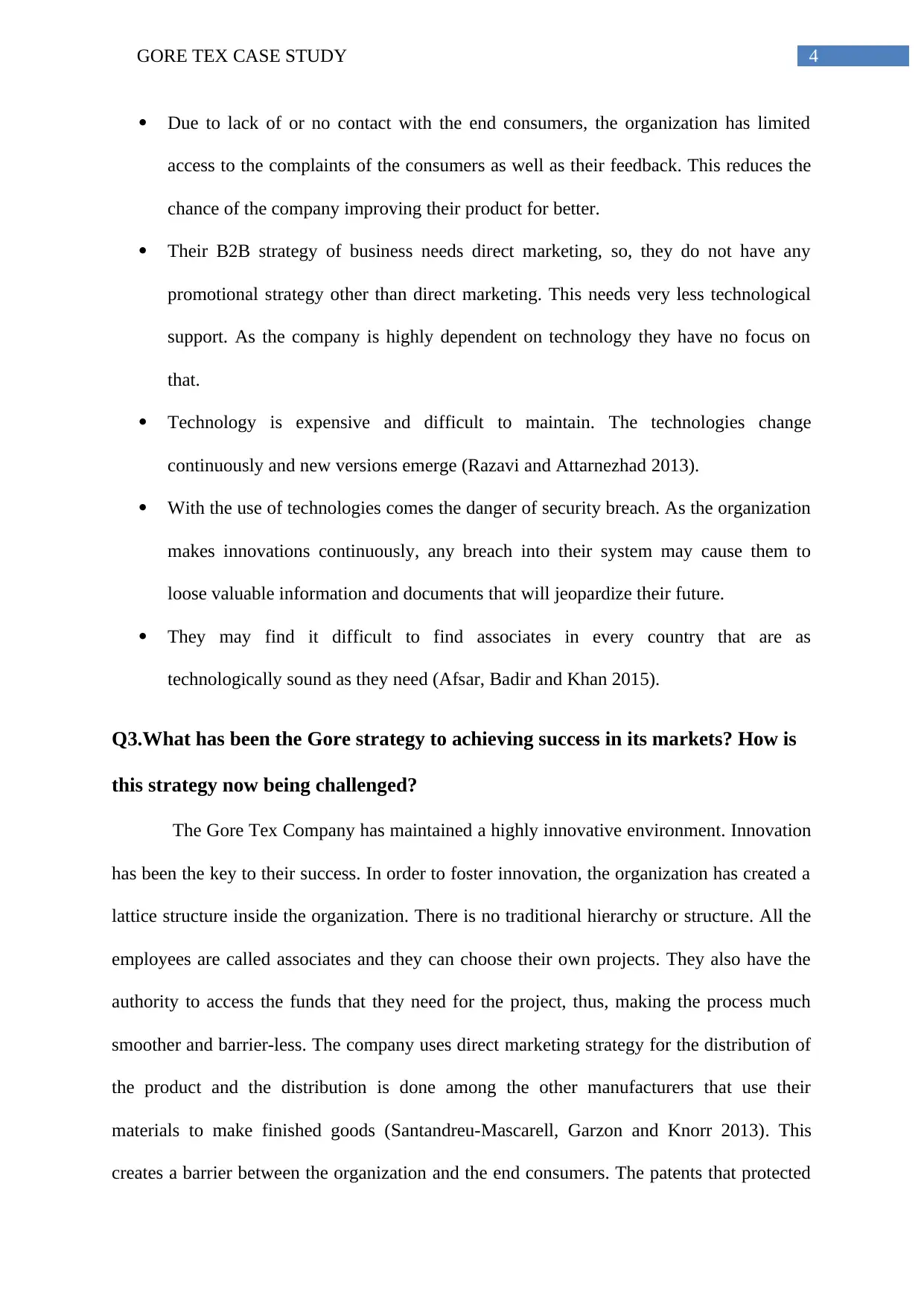
4GORE TEX CASE STUDY
Due to lack of or no contact with the end consumers, the organization has limited
access to the complaints of the consumers as well as their feedback. This reduces the
chance of the company improving their product for better.
Their B2B strategy of business needs direct marketing, so, they do not have any
promotional strategy other than direct marketing. This needs very less technological
support. As the company is highly dependent on technology they have no focus on
that.
Technology is expensive and difficult to maintain. The technologies change
continuously and new versions emerge (Razavi and Attarnezhad 2013).
With the use of technologies comes the danger of security breach. As the organization
makes innovations continuously, any breach into their system may cause them to
loose valuable information and documents that will jeopardize their future.
They may find it difficult to find associates in every country that are as
technologically sound as they need (Afsar, Badir and Khan 2015).
Q3.What has been the Gore strategy to achieving success in its markets? How is
this strategy now being challenged?
The Gore Tex Company has maintained a highly innovative environment. Innovation
has been the key to their success. In order to foster innovation, the organization has created a
lattice structure inside the organization. There is no traditional hierarchy or structure. All the
employees are called associates and they can choose their own projects. They also have the
authority to access the funds that they need for the project, thus, making the process much
smoother and barrier-less. The company uses direct marketing strategy for the distribution of
the product and the distribution is done among the other manufacturers that use their
materials to make finished goods (Santandreu-Mascarell, Garzon and Knorr 2013). This
creates a barrier between the organization and the end consumers. The patents that protected
Due to lack of or no contact with the end consumers, the organization has limited
access to the complaints of the consumers as well as their feedback. This reduces the
chance of the company improving their product for better.
Their B2B strategy of business needs direct marketing, so, they do not have any
promotional strategy other than direct marketing. This needs very less technological
support. As the company is highly dependent on technology they have no focus on
that.
Technology is expensive and difficult to maintain. The technologies change
continuously and new versions emerge (Razavi and Attarnezhad 2013).
With the use of technologies comes the danger of security breach. As the organization
makes innovations continuously, any breach into their system may cause them to
loose valuable information and documents that will jeopardize their future.
They may find it difficult to find associates in every country that are as
technologically sound as they need (Afsar, Badir and Khan 2015).
Q3.What has been the Gore strategy to achieving success in its markets? How is
this strategy now being challenged?
The Gore Tex Company has maintained a highly innovative environment. Innovation
has been the key to their success. In order to foster innovation, the organization has created a
lattice structure inside the organization. There is no traditional hierarchy or structure. All the
employees are called associates and they can choose their own projects. They also have the
authority to access the funds that they need for the project, thus, making the process much
smoother and barrier-less. The company uses direct marketing strategy for the distribution of
the product and the distribution is done among the other manufacturers that use their
materials to make finished goods (Santandreu-Mascarell, Garzon and Knorr 2013). This
creates a barrier between the organization and the end consumers. The patents that protected
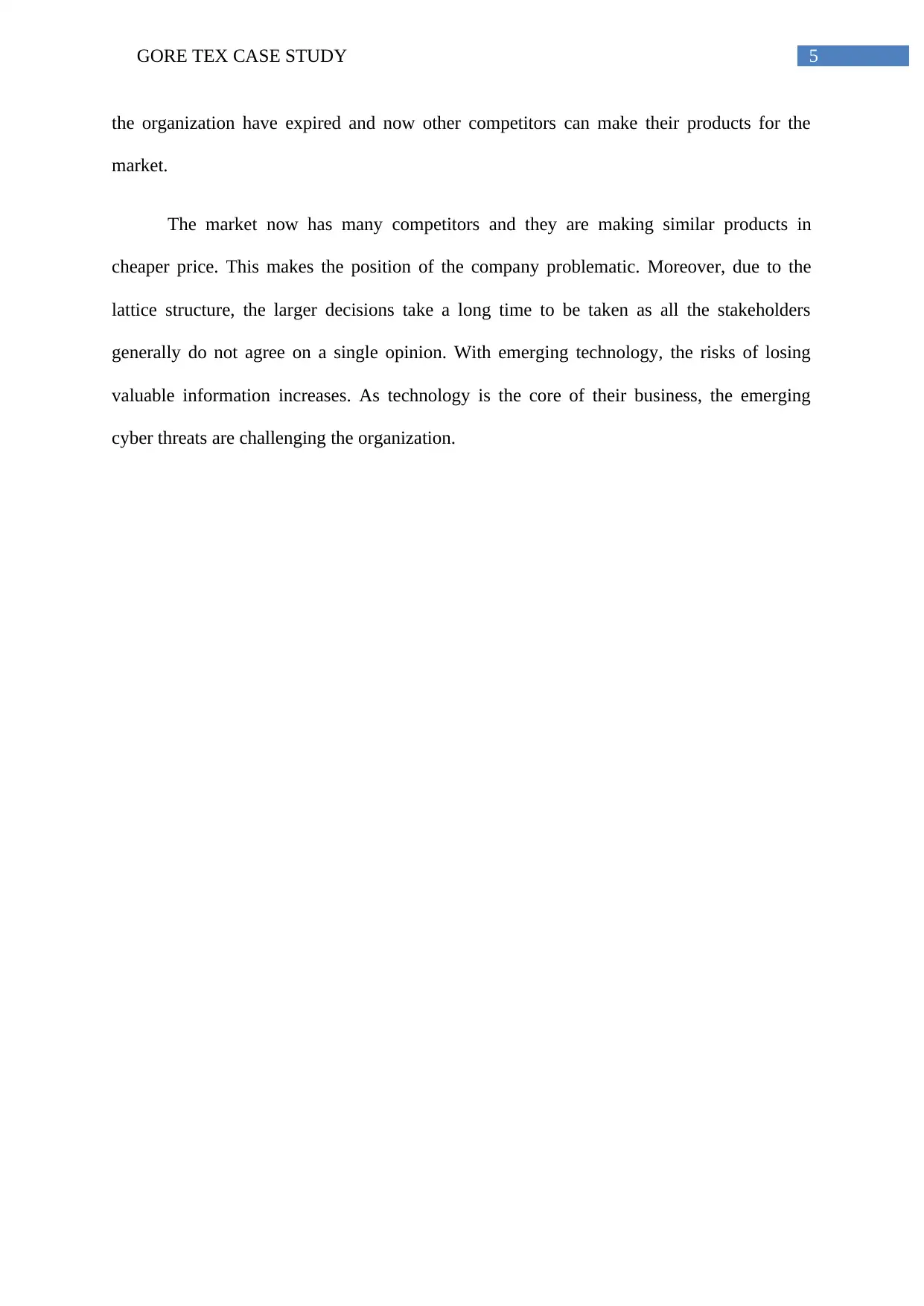
5GORE TEX CASE STUDY
the organization have expired and now other competitors can make their products for the
market.
The market now has many competitors and they are making similar products in
cheaper price. This makes the position of the company problematic. Moreover, due to the
lattice structure, the larger decisions take a long time to be taken as all the stakeholders
generally do not agree on a single opinion. With emerging technology, the risks of losing
valuable information increases. As technology is the core of their business, the emerging
cyber threats are challenging the organization.
the organization have expired and now other competitors can make their products for the
market.
The market now has many competitors and they are making similar products in
cheaper price. This makes the position of the company problematic. Moreover, due to the
lattice structure, the larger decisions take a long time to be taken as all the stakeholders
generally do not agree on a single opinion. With emerging technology, the risks of losing
valuable information increases. As technology is the core of their business, the emerging
cyber threats are challenging the organization.
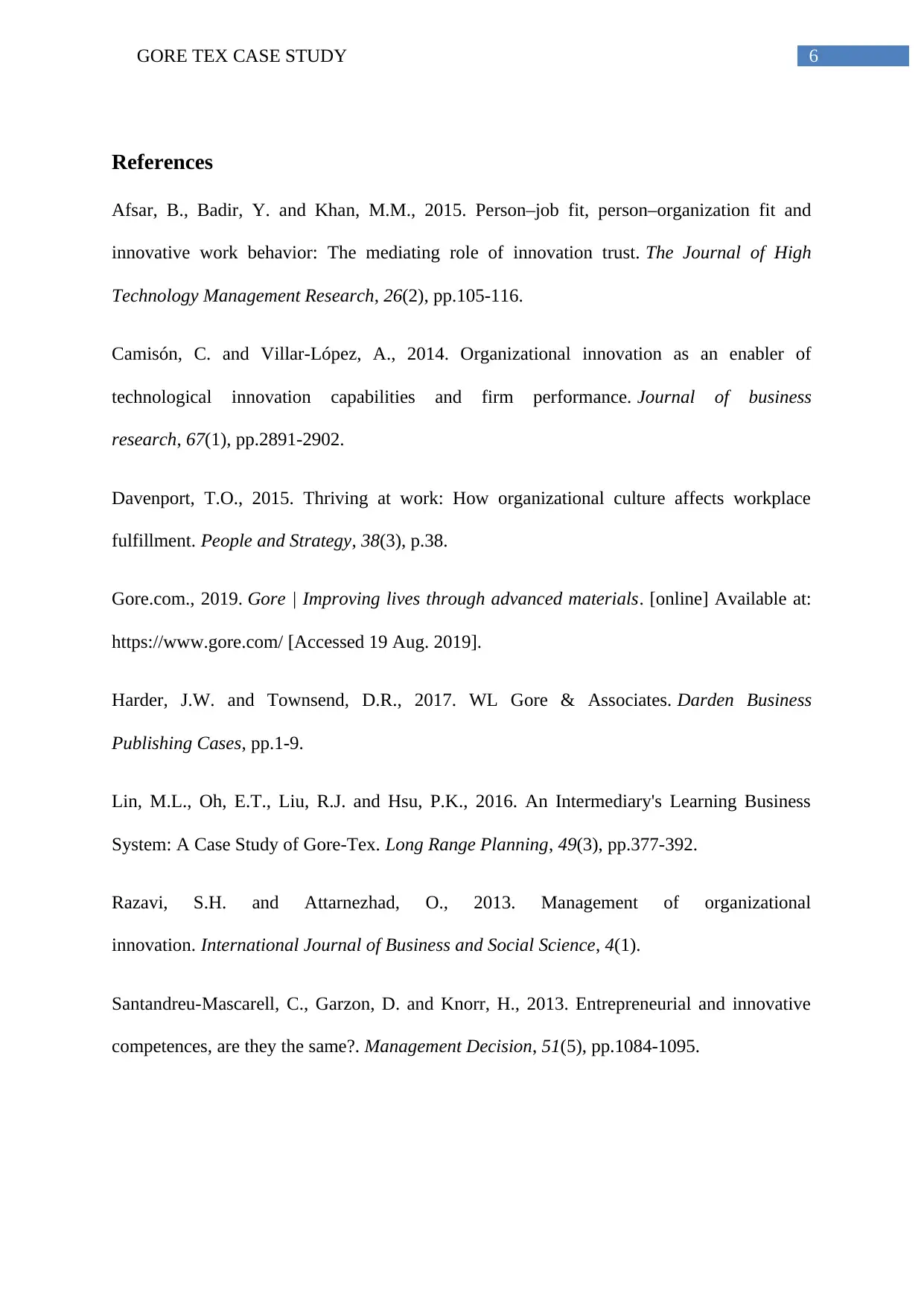
6GORE TEX CASE STUDY
References
Afsar, B., Badir, Y. and Khan, M.M., 2015. Person–job fit, person–organization fit and
innovative work behavior: The mediating role of innovation trust. The Journal of High
Technology Management Research, 26(2), pp.105-116.
Camisón, C. and Villar-López, A., 2014. Organizational innovation as an enabler of
technological innovation capabilities and firm performance. Journal of business
research, 67(1), pp.2891-2902.
Davenport, T.O., 2015. Thriving at work: How organizational culture affects workplace
fulfillment. People and Strategy, 38(3), p.38.
Gore.com., 2019. Gore | Improving lives through advanced materials. [online] Available at:
https://www.gore.com/ [Accessed 19 Aug. 2019].
Harder, J.W. and Townsend, D.R., 2017. WL Gore & Associates. Darden Business
Publishing Cases, pp.1-9.
Lin, M.L., Oh, E.T., Liu, R.J. and Hsu, P.K., 2016. An Intermediary's Learning Business
System: A Case Study of Gore-Tex. Long Range Planning, 49(3), pp.377-392.
Razavi, S.H. and Attarnezhad, O., 2013. Management of organizational
innovation. International Journal of Business and Social Science, 4(1).
Santandreu-Mascarell, C., Garzon, D. and Knorr, H., 2013. Entrepreneurial and innovative
competences, are they the same?. Management Decision, 51(5), pp.1084-1095.
References
Afsar, B., Badir, Y. and Khan, M.M., 2015. Person–job fit, person–organization fit and
innovative work behavior: The mediating role of innovation trust. The Journal of High
Technology Management Research, 26(2), pp.105-116.
Camisón, C. and Villar-López, A., 2014. Organizational innovation as an enabler of
technological innovation capabilities and firm performance. Journal of business
research, 67(1), pp.2891-2902.
Davenport, T.O., 2015. Thriving at work: How organizational culture affects workplace
fulfillment. People and Strategy, 38(3), p.38.
Gore.com., 2019. Gore | Improving lives through advanced materials. [online] Available at:
https://www.gore.com/ [Accessed 19 Aug. 2019].
Harder, J.W. and Townsend, D.R., 2017. WL Gore & Associates. Darden Business
Publishing Cases, pp.1-9.
Lin, M.L., Oh, E.T., Liu, R.J. and Hsu, P.K., 2016. An Intermediary's Learning Business
System: A Case Study of Gore-Tex. Long Range Planning, 49(3), pp.377-392.
Razavi, S.H. and Attarnezhad, O., 2013. Management of organizational
innovation. International Journal of Business and Social Science, 4(1).
Santandreu-Mascarell, C., Garzon, D. and Knorr, H., 2013. Entrepreneurial and innovative
competences, are they the same?. Management Decision, 51(5), pp.1084-1095.
Paraphrase This Document
Need a fresh take? Get an instant paraphrase of this document with our AI Paraphraser
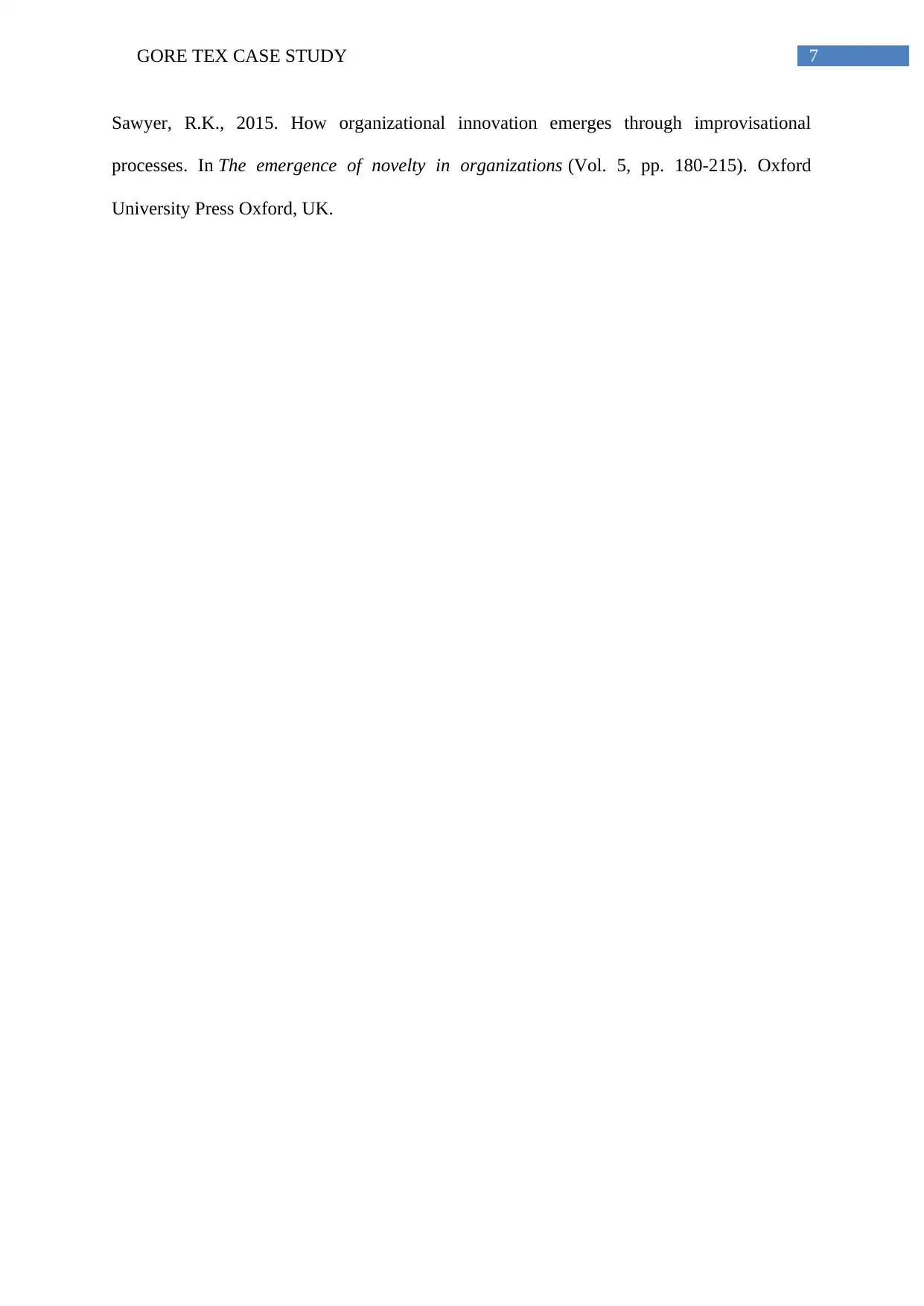
7GORE TEX CASE STUDY
Sawyer, R.K., 2015. How organizational innovation emerges through improvisational
processes. In The emergence of novelty in organizations (Vol. 5, pp. 180-215). Oxford
University Press Oxford, UK.
Sawyer, R.K., 2015. How organizational innovation emerges through improvisational
processes. In The emergence of novelty in organizations (Vol. 5, pp. 180-215). Oxford
University Press Oxford, UK.
1 out of 8
Related Documents
Your All-in-One AI-Powered Toolkit for Academic Success.
+13062052269
info@desklib.com
Available 24*7 on WhatsApp / Email
![[object Object]](/_next/static/media/star-bottom.7253800d.svg)
Unlock your academic potential
© 2024 | Zucol Services PVT LTD | All rights reserved.





